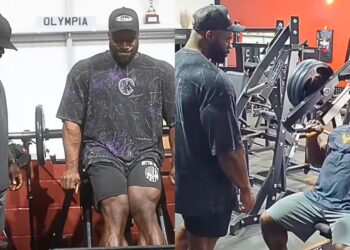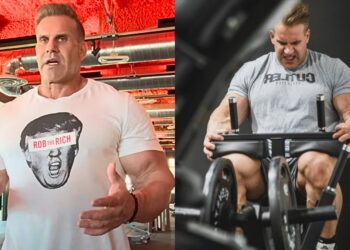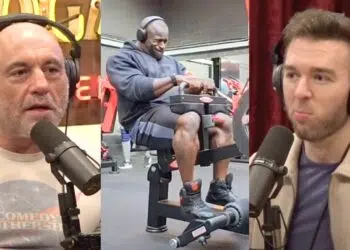Do you have trouble squatting below parallel? Can you only hit depth when your heels are raised on blocks? Do your heels lift as you descend into a deep squat?
Sounds like you may have tight calves!
Despite being one of the smallest leg muscles, the calves play a big part in the form and function of your lower body. Tight calves can put unnecessary stress on your knees and negatively impact your athletic performance. They could even lead to Achilles tendon inflammation and injury.
We’ve discussed the soleus in this article, so today, we’re going to focus on the other calf muscle – the gastrocnemius.
[Related: Why Your Calves Are Skinny, And How to Fix Them]
Calf Anatomy
While you don’t need an intimate knowledge of calf anatomy and physiology to stretch your gastrocnemius, it may be helpful to know a little more about how it functions so that you can stretch it effectively.
Level Up Your Fitness: Join our 💪 strong community in Fitness Volt Newsletter. Get daily inspiration, expert-backed workouts, nutrition tips, the latest in strength sports, and the support you need to reach your goals. Subscribe for free!
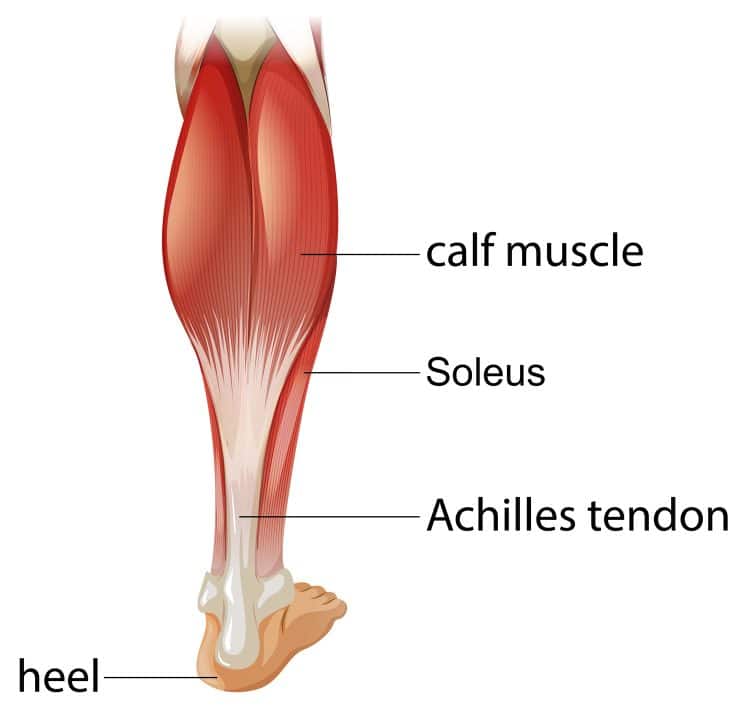
The calves are made of two muscles, but, weirdly, a small number of people have a third calf muscle, too.
Gastrocnemius
The gastrocnemius is the dual-headed outermost calf muscle that makes up most of your lower leg girth. The gastroc is a biaxial muscle, meaning it crosses two joints – the ankle and the knee. As such, it has two functions.
The primary role of the gastrocnemius is plantar flexion of the ankle. This means pointing your toe, as happens during calf raises.
The second function of the gastrocnemius is knee flexion. It works with the hamstrings to help bend your knees. Watch your calves during leg curls to see them contract to aid your hamstrings. However, this is quite a weak action compared to plantar flexion.
Because of these functions, a tight gastrocnemius can affect your knee and your ankle joint. In fact, many knee issues are directly caused by tight calves, as they can alter your gait and squat mechanics, placing more stress on your knee joints.
Soleus
The second main calf muscle, the soleus, lies beneath the gastrocnemius, and only the lower section is visible. Unlike the gastroc, the soleus is a uniaxial muscle that only crosses one joint; the ankle.
As such, the soleus only has one main function – plantarflexion.
While soleus and gastrocnemius work together, it is possible to emphasize the soleus by working with bent knees. When your knees are bent, the gastrocnemius is put into a semi-relaxed position and cannot contribute as much to plantar flexion. For that reason, your knee should be straight to stretch your gastrocnemius.
Plantaris
Plantaris is a small, thin muscle that some people have, and others do not. If you have one, it’s located behind and works with the gastrocnemius to plantar flex the ankle and flex the knee.
It is hypothesized that this muscle was necessary for climbing and moving around on all fours. However, since we evolved to walk upright, it has become less necessary, and fewer and fewer people (about 8-12 percent) now have it (1).
Do YOU have a plantaris muscle? Who knows! The only way to find out is through a DEXA scan, which is a type of x-ray.
Best Gastrocnemius Stretches for Tight Calves
The gastrocnemius is a strong muscle which means it can be very resistant to stretching. As such, you may need to put a lot of weight through your calves to get a sufficiently deep gastroc stretch.
However, the tendon that attaches your calf muscle to your heel is a site of potential weakness, so you should always gradually ease into your gastrocnemius stretches. Loading the muscle too quickly could cause serious injury. Ruptured Achilles tendons take a long time to heal and may require surgery.
So, stretch your calves purposely but don’t try to reach a deep stretch too quickly. Instead, ease into the stretch, hold for a few seconds, and only descend further as you feel your muscles begin to relax.
Here are seven of the best gastrocnemii stretches:
1. Standing gastrocnemius stretch against a wall
This stretch is ideal for warming up before a run or some other type of cardio. All you need to do it is a wall to lean on. Working one calf at a time means you can use this exercise to determine if you have one calf tighter than the other.
How to do it:
- Stand a short distance from a wall. Lean forward and place your hands against it at about shoulder height.
- Step back with one leg and press your heel into the floor.
- Move your foot further back to increase the stretch.
- Hold for 30-60 seconds, and then switch legs.
Pro tip: Push tour bent knee forward toward the wall to simultaneously stretch the soleus on your other leg.
2. Gastrocnemius stretch on a step
While #1 is a very effective exercise, it’s not all that easy to get a deep stretch. As your flexibility improves, you’ll find yourself having to move your feet further and further back from the wall. This next exercise has no such limitations, so you can get a much deeper stretch more comfortably.
Level Up Your Fitness: Join our 💪 strong community in Fitness Volt Newsletter. Get daily inspiration, expert-backed workouts, nutrition tips, the latest in strength sports, and the support you need to reach your goals. Subscribe for free!
How to do it:
- Stand with the balls of your feet on the edge of a step or curb. Use your arms for balance as required. Keep your knees straight.
- Let gravity gently pull your heels down toward the floor.
- Hold this position for 30-60 seconds, increasing the stretch as you feel your muscles relax.
Pro tip: Increase the intensity of your calf stretch by focusing on one leg at a time. Either a) bend one knee slightly to shift more weight onto one leg, or b) do this exercise entirely on one leg, crossing non-working leg behind you, like this, watch the video.
3. Assisted seated gastrocnemius stretch
The assisted gastrocnemius stretch is the ideal exercise when you are coming back from a lower limb injury, e.g., a muscle strain or sprained ankle. After an injury, you won’t want to stretch your muscles too aggressively. Using a strap means you can stretch your calves with less force than you would if you had to rely on your body weight.
How to do it:
- Sit on the floor with one leg extended in front of you. Place your other leg wherever it feels comfortable, e.g., knee bent and foot against your inner thigh.
- Loop a yoga strap or belt over the ball of your outstretched foot.
- Gently pull on the strap to bring the ball of your foot toward your shin.
- Hold for 30-60 seconds, increasing the stretch as you feel your muscles relax.
- Swap legs and repeat.
Pro tip: Combine your calf stretch with a hamstring stretch by lying back, extending your leg vertically, and pulling the ball of your foot downward, like this:
4. Downward dog
The downward dog is a powerful stretch for the entire posterior chain, including your gastrocnemius. It’s also an excellent postural exercise that will open your shoulders and chest. As a final benefit, doing the downward dog will tone and condition your arms, abs, and deltoids.
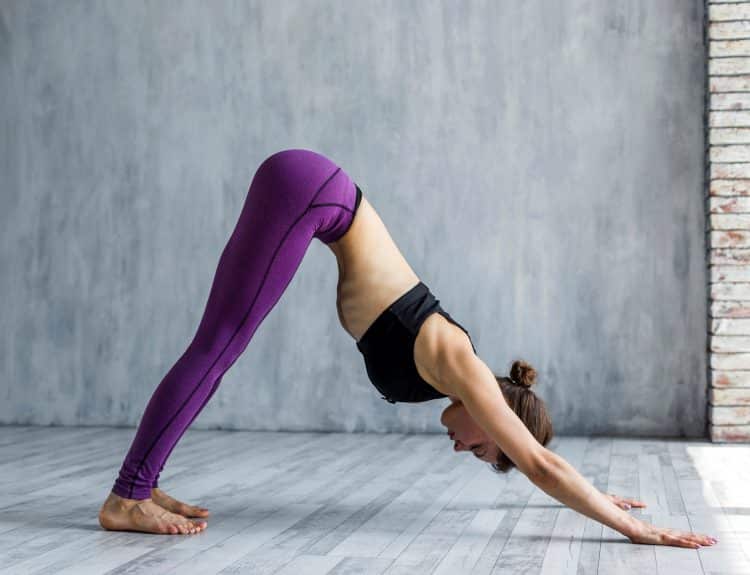
How to do it:
- Adopt the push-up position with your arms straight, hands about shoulder-width apart. Brace your abs, and pull your shoulders back and down.
- Lift your hips, push back with your arms, and press your heels toward the floor, so your body forms an inverted V.
- Look back toward your knees and gently press your chest between your arms.
- Hold for 30 to 60 seconds, gently increasing the stretch as you feel your muscles relax.
Pro tip: Emphasize your gastrocnemii by bending one leg and pressing your other heel closer to the floor. Make sure you stretch both calves equally.
5. Toes on wall calf stretch
Suppose you’ve already got good calf mobility. In that case, you may find that some of the exercises in this article don’t really work very well for you. Don’t worry – there are still plenty of stretches you can do, even if your calves are long and limber!
This is a variation of the wall stretch we covered all the way back at the beginning of the article, but the range of motion is bigger, so it provides a deeper, more intense stretch.
How to do it:
- Stand close to a wall. Move one leg forward and place your toes on the wall, so your ankle is in a plantar flexed position. You should feel a mild stretch in your gastrocnemius at this point.
- Lean toward the wall to increase the intensity of the stretch.
- Hold for 30-60 seconds, increasing the stretches you feel your muscles relax.
- Switch sides and repeat.
Pro tip: Remove your shoes so you can flex your toes upward. This will stretch the sole of your foot as well as your calves. The soles of the feet can become tight, leading to issues such as plantar fasciitis.
6. Lunging calf stretch
You can do the lunging calf stretch almost anywhere and anytime – even right now! It’s a useful warm-up exercise that’s ideal for doing before a run or cardio workout. You won’t get a deep stretch from this exercise, but it’s certainly enough to loosen up your muscles and reduce your risk of injury.
How to do it:
- Take a large step forward and into a lunge. Keep your back leg straight.
- Push your rear heel down toward the floor.
- Hold for 30-60 seconds, increasing the stretch as you feel your muscles relax. Move your front foot forward to deepen the stretch.
- Swap legs and repeat.
Pro tip: If balancing is difficult, do this exercise next to a wall, fence, lamppost, etc., and place one hand on it for support.
7. Foam rolling the gastrocnemius
Your muscles are surrounded by a thin layer of fibrous tissue called fascia. Fascia separates and connects each muscle from its neighbor. This fascia can become “gummed up,” leading to tight, painful muscles. This can cause trigger points, poor blood flow, and reduced function.
Foam rolling is a form of self-massage called self-myofascial release that can help free up your fascia and restore normal movement and function. Foam rolling your gastrocnemius will enhance your flexibility and performance.
How to do it:
- Sit on the floor with your legs extended in front of you. Place your foam roller behind one calf. Support your weight on your hands.
- Lifting your butt off the floor, move your leg forward and back to roll along your upper calf. Rotate your hip in and out to hit both sides of your calves.
- Seek out any areas of tightness and spend a little longer working on them until they start to diminish.
- Increase the pressure by crossing your other leg over the one you’re treating.
- Continue for 2-4 minutes, and then swap sides.
Pro tip: Save time and energy by rolling both calves at once. This is also a useful option if your calves are tender and foam rolling is very uncomfortable.
Gastrocnemius Stretches – Wrapping Up
For such a small muscle, the gastrocnemius can cause a lot of problems if it’s allowed to become overly tight. It can prevent you from squatting correctly and even increase your risk of knee pain.
Unfortunately, if you spend a lot of time sitting or driving, the gastrocnemius can soon begin to tighten up. This is called adaptive shortening, which describes how your calves become accustomed to being kept in a semi-contracted position.
Thankfully, the calves are very responsive to regular flexibility training, and there are plenty of calf stretches you can do to lengthen them.
So, if your heels lift during squats, or you find it almost impossible to descend below parallel because your knees won’t travel forward enough, you NEED to start stretching your calves.
Not just after your leg workouts but for a few minutes every day. Do this, and you’ll soon begin to notice improvements in ankle mobility and squat depth.
References:
1 – PubMed: Evolutionary anatomy of the plantar aponeurosis in primates, including humans https://www.ncbi.nlm.nih.gov/pmc/articles/PMC7309290/



